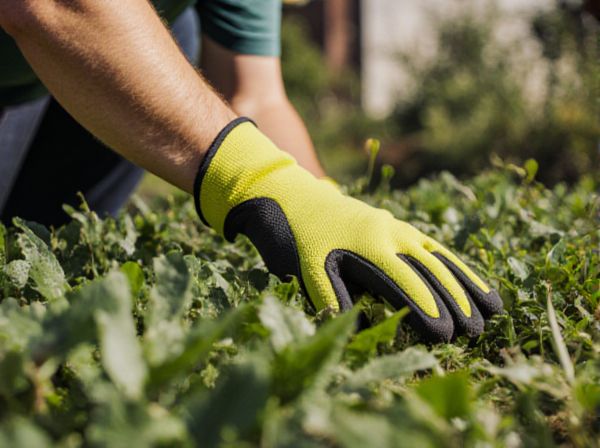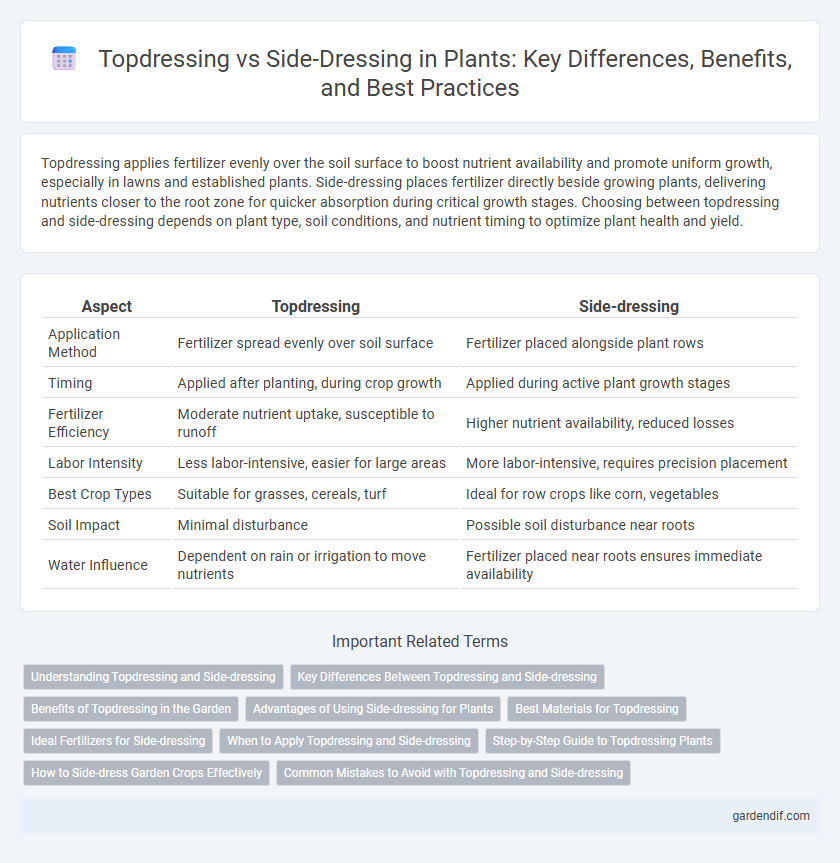
Topdressing vs Side-dressing Illustration
Topdressing applies fertilizer evenly over the soil surface to boost nutrient availability and promote uniform growth, especially in lawns and established plants. Side-dressing places fertilizer directly beside growing plants, delivering nutrients closer to the root zone for quicker absorption during critical growth stages. Choosing between topdressing and side-dressing depends on plant type, soil conditions, and nutrient timing to optimize plant health and yield.
Table of Comparison
| Aspect | Topdressing | Side-dressing |
|---|---|---|
| Application Method | Fertilizer spread evenly over soil surface | Fertilizer placed alongside plant rows |
| Timing | Applied after planting, during crop growth | Applied during active plant growth stages |
| Fertilizer Efficiency | Moderate nutrient uptake, susceptible to runoff | Higher nutrient availability, reduced losses |
| Labor Intensity | Less labor-intensive, easier for large areas | More labor-intensive, requires precision placement |
| Best Crop Types | Suitable for grasses, cereals, turf | Ideal for row crops like corn, vegetables |
| Soil Impact | Minimal disturbance | Possible soil disturbance near roots |
| Water Influence | Dependent on rain or irrigation to move nutrients | Fertilizer placed near roots ensures immediate availability |
Understanding Topdressing and Side-dressing
Topdressing involves applying a thin layer of fertilizer or organic material evenly over the soil surface, enhancing nutrient availability and improving soil structure for plants. Side-dressing places fertilizer directly alongside growing plants, targeting root zones to supply nutrients during critical growth stages for optimal uptake. Understanding the differences helps gardeners and farmers optimize nutrient management strategies according to plant needs and growth phases.
Key Differences Between Topdressing and Side-dressing
Topdressing involves applying fertilizer or organic material directly onto the soil surface around plants, enhancing nutrient availability and improving soil structure without disturbing plant roots. Side-dressing is the application of fertilizer in bands alongside growing plants, targeting nutrient delivery to the root zone during critical growth stages for efficient uptake. The key difference lies in the timing and method of application, where topdressing is often done before or during early growth, while side-dressing is strategically applied mid-season to meet the plants' nutrient demands.
Benefits of Topdressing in the Garden
Topdressing enriches soil by evenly distributing nutrients and organic matter directly on the garden surface, promoting consistent nutrient availability for plants. It improves soil structure, enhances moisture retention, and stimulates beneficial microbial activity, leading to healthier root development. Compared to side-dressing, topdressing is less disruptive to plant roots, making it ideal for established gardens requiring gradual nutrient supplementation.
Advantages of Using Side-dressing for Plants
Side-dressing delivers nutrients directly to the root zone, enhancing nutrient uptake and reducing wastage compared to topdressing. This method allows for timely fertilizer application during critical growth stages, promoting healthier plant development and higher yields. Targeted nutrient placement minimizes soil erosion and nutrient run-off, supporting sustainable agricultural practices.
Best Materials for Topdressing
Topdressing involves applying a thin layer of materials such as compost, sand, or finely screened topsoil directly onto the soil surface, promoting healthy plant growth and improving soil structure. Organic materials like well-aged compost and humus-rich soil amendments are best for topdressing as they enhance nutrient availability and moisture retention. In contrast, side-dressing typically uses granular fertilizers applied alongside plants to provide targeted nutrient delivery during the growing season.
Ideal Fertilizers for Side-dressing
Ideal fertilizers for side-dressing include nitrogen-rich options like urea and ammonium nitrate, which promote rapid nutrient uptake by plants during critical growth stages. Side-dressing with these fertilizers enhances root development and increases crop yield by supplying nutrients close to the plant base. Applying phosphorus and potassium alongside nitrogen in side-dressing ensures balanced nutrition essential for healthy plant growth and disease resistance.
When to Apply Topdressing and Side-dressing
Topdressing is typically applied during the active growing season to provide nutrients directly to the soil surface, enhancing grass health and color without disturbing plant roots. Side-dressing is best administered alongside growing plants, often during critical growth stages such as flowering or fruiting, to supply targeted nutrients near the root zone for optimal uptake. Timing these applications according to plant development phases ensures efficient nutrient absorption and improved crop yield.
Step-by-Step Guide to Topdressing Plants
Topdressing plants involves applying a thin layer of nutrient-rich compost or fertilizer directly onto the soil surface around the base, enhancing soil fertility and promoting healthy growth. Begin by removing weeds and debris, then evenly spread a 1/4 to 1/2 inch layer of organic matter, such as well-aged compost or balanced granular fertilizer, avoiding burying the plant crown. Water the area lightly to help nutrients infiltrate the soil, and repeat throughout the growing season as needed to maintain optimal plant nutrition.
How to Side-dress Garden Crops Effectively
To side-dress garden crops effectively, apply nitrogen-rich fertilizer in a band 2 to 4 inches away from the plant base, ensuring nutrients reach the root zone without causing burn. Timing is crucial; side-dress during active growth stages, typically when plants have developed several true leaves or begin flowering, to boost nutrient uptake and promote robust development. Consistent watering after application aids in nutrient absorption and prevents fertilizer runoff, maximizing the growth benefits for vegetables like tomatoes, corn, and beans.
Common Mistakes to Avoid with Topdressing and Side-dressing
Common mistakes to avoid with topdressing and side-dressing include applying fertilizer too close to plant stems, which can cause root burn and inhibit growth. Over-application during topdressing can lead to nutrient runoff and environmental pollution, while side-dressing errors often involve uneven distribution, reducing nutrient uptake efficiency. Ensuring proper timing, accurate fertilizer amounts, and targeted placement are essential for maximizing plant health and minimizing wasted resources.
Topdressing vs Side-dressing Infographic

 gardendif.com
gardendif.com